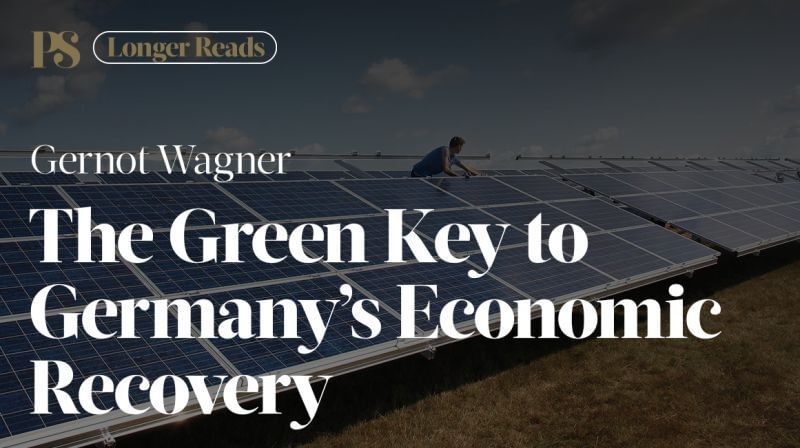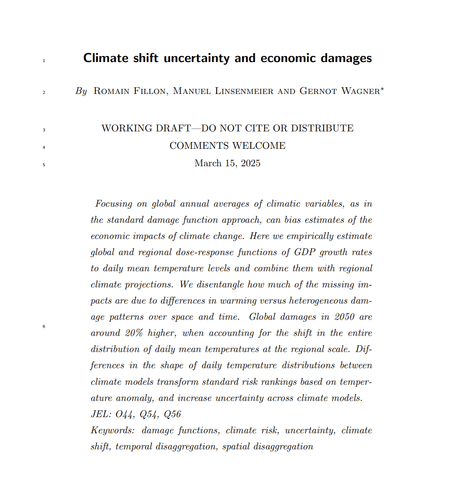How bad can it be?
We’ve learned quite a bit since the last IPCC report, and the news isn’t exactly good
In ten days, the Intergovernmental Panel on Climate Change (IPCC) will unveil the next major step in its latest assessment report. This week and next, Working Group II is convening to finalize its report on “Impacts, Adaptation and Vulnerability,” short for how much climate change costs, and how we’ll cope. (Working Group III, on mitigation, is slated to follow in April.)
There are lots of good reasons to believe that climate science and economics are inherently conservative. Science is. But the IPCC has traditionally been pushing toward being more conservative than most.
The prior assessment report stated that “the incomplete estimates of global annual economic losses for additional temperature increases of ~2°C are between 0.2 and 2.0% of income.” That’s low, even for when it came out in 2014.
To be clear, the statement was appropriately caveated. The full paragraph begins: “Global economic impacts from climate change are difficult to estimate.” It also states how “many estimates do not account for catastrophic changes, tipping points, and many other factors.” But with or without these caveats, the numbers provided ample ammunition to those wanting to downplay climate damages: even 2%, after all, is a rather small price to pay with total global average warming of around 2.6°C (well over 4.5°F).
Since then, the climate economic profession has made significant headway in tallying what can be quantified, and in making sense of the remaining risks and uncertainties that often can’t.
I can’t give you a preview of what the IPCC report will say. (I’m not part of the effort nor privy to any advance info. I’m part of both the NPCC & APCC, the New York City and Austrian versions, respectively, the mere existence of which indicates how important the IPCC is in setting the tone for many other such climate impact analyses.)
I can try to preview where I think things ought to go. And there, one thing is clear. Almost every time another paper comes out quantifying what can indeed be quantified, monetizing what the late U.S. defense secretary Don Rumsfeld might call the “known knowns,” climate damages go up.
For one, thanks to massive data efforts like the Climate Impact Lab, climate economists have made large strides in translating climate impacts into dollars and cents—dollars mainly, given the uncertainties involved, and given the fact that the costs really add up. That means building regionally disaggregated damage functions, from the bottom up. It’s painstaking work. It also makes a real difference. For example, the costs of premature climate-related deaths alone increases the cost of each ton of CO2 emitted today by at least around $20. That’s up from a big fat $0 from prior such estimates entering Social Cost of Carbon (SCC) estimates.
Many of these additional costs are not due to global average temperatures, but due to extremes. For those in temperate climates, the small increase in average temperatures might even count as pleasant. But it’s the increase in extreme heat, days with temperatures above 32°C (90F), say, that have the largest negative impacts.
Heat kills people, animals, and crops alike. It lowers worker productivity, especially in poorer areas. Hotter temperatures have been linked conclusively to more road rage and car crashes, to more domestic violence and assaults, and to both police aggression and robberies. There are strong overall links between heat and other climatic events and conflict, from peasant rebellions in the Chinese Qing dynasty to ethnic riots in India to conflicts and coups everywhere.
Tallying these individual studies alone is yeoman's work. The next step of translating the impacts into dollars and on to headline figures akin to the “0.2 to 2.0%” of GDP is equally important. It’s a neat statistical exercise to link heat during baseball games to more pitchers hitting batters with errant balls as apparent retaliation, but unless there’s a dollar impact, the impact will get lost in the scrum, for a hopeless mix of sports metaphors. (And no, I’m not saying that particular result should find its way into economic impact assessments. The economic impact of foul balls seems to be rather limited.)
Then there are the remaining risks and uncertainties that can’t be put in a damage function. Think of them as the “known unknowns” and “unknown unknowns.” For the most part, they, too, increase the social cost of carbon, or at least ought to. The 2014 IPCC report essentially left them out. The new report ought not get off so easily.
I don’t envy those who have worked hard on putting together the next IPCC assessment report. Some of the choices facing the co-authors are just impossible to get right. In the end, though, there are clearly ways to improve the treatment of risk and uncertainty in climate-economic assessments. It doesn’t mean going all the way to the late great Marty Weitzman’s “dismal theorem,” showing that tail events dominate all else. But it does mean grappling with how risk and risk aversion should enter the analysis, which in turn has important implications for how equity and discounting gets treated, both of which would raise the SCC further still.
Climate economics has come a long way since Bill Nordhaus caveated the paper introducing his Nobel Prize-winning DICE model three decades ago by saying how “it should be emphasized that this analysis has a number of important qualifications,” including “the economic impact of climate change.” That’s quite the caveat for a model focused on quantifying the economic impacts of climate change. The IPCC report ought to reflect those enormous advances since 1992, and since the prior comprehensive assessment report published in 2014.


